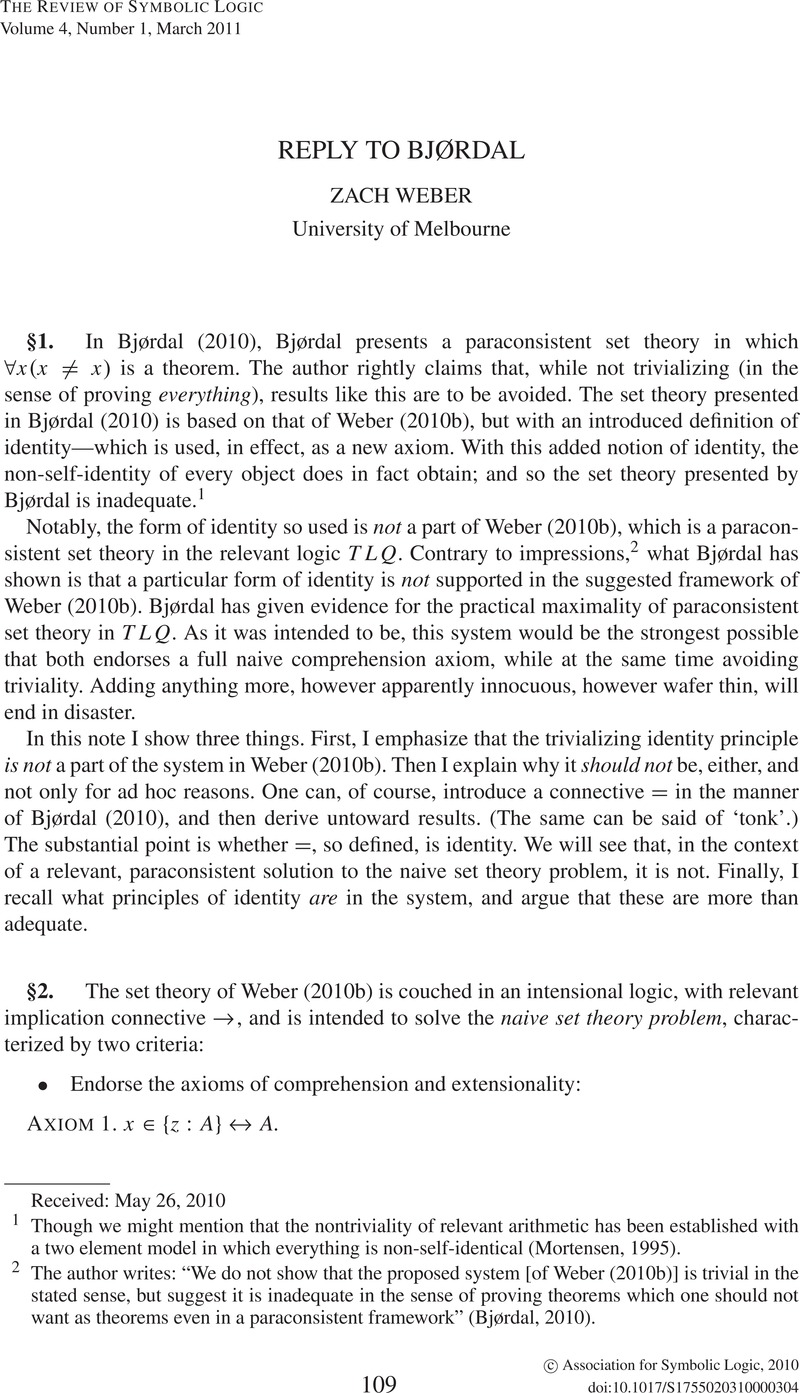No CrossRef data available.
Article contents
REPLY TO BJØRDAL
Published online by Cambridge University Press: 11 March 2011
Abstract
An abstract is not available for this content so a preview has been provided. Please use the Get access link above for information on how to access this content.

- Type
- Reply
- Information
- Copyright
- Copyright © Association for Symbolic Logic 2010
References
BIBLIOGRAPHY
Bjørdal, F. (2011). The inadequacy of a proposed paraconsistent set theory. Review of Symbolic Logic, 4(1), 106–108.CrossRefGoogle Scholar
Brady, R. T. (1971). The consistency of the axioms of the axioms of abstraction and extensionality in a three valued logic. Notre Dame Journal of Formal Logic, 12, 447–453.CrossRefGoogle Scholar
Brady, R. T. (1989). The non-triviality of dialectical set theory. In Priest, G., Routley, R., and Norman, J., editors. Paraconsistent Logic: Essays on the Inconsistent. Munich, Germany: Philosophia Verlag, pp. 437–470.CrossRefGoogle Scholar
Chang, C. C. (1963). The axiom of comprehension in infinite valued logic. Mathematica Scandinavica, 13, 9–30.CrossRefGoogle Scholar
Dunn, J. M. (1987). Relevant predication 1: The formal theory. Journal of Philosophical Logic, 16, 347–381.CrossRefGoogle Scholar
Gilmore, P. C. (1974). The consistency of partial set theory without extensionality. In Jech, T., editor. Axiomatic Set Theory. Providence American Mathematical Society, pp. 147–153.CrossRefGoogle Scholar
Kremer, P. (1999). Relevant identity. Journal of Philosophical Logic, 28, 199–222.CrossRefGoogle Scholar
Libert, T. (2005). Models for paraconsistent set theory. Journal of Applied Logic, 3, 15–41.CrossRefGoogle Scholar
Mares, E. (1992). Semantics for relevant logic with identity. Studia Logica, 51, 1–20.CrossRefGoogle Scholar
Meyer, R. K., Routley, R., & Dunn, M. J. (1978). Curry’s paradox. Analysis, 39, 124–128.CrossRefGoogle Scholar
Mortensen, C. (1995). Inconsistent Mathematics. Dordrecht: Kluwer Academic Publishers.CrossRefGoogle Scholar
Petersen, U. (2000). Logic without contraction as based on inclusion and unrestriced abstraction. Studia Logica, 64, 365–403.CrossRefGoogle Scholar
Priest, G., Routley, R., & Norman, J., editors. (1989). Paraconsistent Logic: Essays on the Inconsistent. Munich, Germany: Philosophia Verlag.Google Scholar
Weber, Z. (2010a). Extensionality and restriction in naive set theory. Studia Logica, 94(1), 87–104.CrossRefGoogle Scholar
Weber, Z. (2010b). Transfinite numbers in paraconsistent set theory. Review of Symbolic Logic, 3(1), 71–92.CrossRefGoogle Scholar
White, R. (1979). The consistency of the axiom of comprehension in the infinite valued predicate logic of łukasiewicz. Journal of Philosophical Logic, 8, 503–534.CrossRefGoogle Scholar


